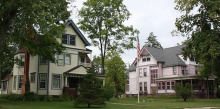
It’s been about two years since the people of Lincoln County, Wisconsin, learned that Frontier Communications received federal funding to expand Internet access in their region. Now, they’re wondering why Frontier has still not started construction of promised infrastructure.
A Long Road To Nowhere
The community has been seeking ways to improve local connectivity for years. Back in 2013, they held a series of local listening sessions and workshops with officials from the University of Wisconsin-Extension Center for Community Technology Solutions. The goals of the workshops were to educate community members about the importance of connectivity and to learn more about the availability of Internet access at the local level. The meetings addressed both residential and business needs.
In the summer of 2015, county officials announced that they had been working on an initiative to find a way to improve connectivity throughout Lincoln County. By engaging members of the public in town hall forums they had learned that the general consensus was:
“For the most part, people are disappointed with their current service.”
“Generally speaking, their current Internet service is not fast enough and there just isn’t enough capacity to do what they want to do.”
Community leaders were also learning that a fair number of home-based businesses were popping up in the county.
As part of their initiative, the board had worked with the UW Extension Office, County Economic Development Corporation and County Information Technology Department. They also passed a resolution stating that they would do everything they could to expand broadband to every resident in the county. County officials began having meetings to develop a plan to meet their goal. Shortly after, they learned that Frontier had accepted Connect America Funding Phase II (CAF II), federal funding designed specifically to expand connectivity in rural areas considered unserved and underserved.
Frontier would use part of the CAF II to expand its services in Lincoln County. Frontier assured the county that the build-out would likely begin in the spring of 2016 and be completed by late 2020. Did this mean they would finally get high-quality connectivity?
But Is It An Improvement?

At the time, many in the community were excited. A majority of the county is rural and considered underserved or unserved; a survey developed by the UW Extension Office and one of the Lincoln County towns that was conducted at the time suggested almost half of respondents didn’t have any Internet access. More than 80 percent of those responding who lived in towns said they were unhappy with the service they received.
The results weren’t unusual for rural areas or for towns in rural regions. Unfortunately, Frontier and other telephone companies that receive CAF II funding are not using the federal subsidies to invest in fiber optic networks - they're using it to expand DSL. In other words, when Frontier finally builds out in Lincoln County, it will be to provide more Internet access akin to that which leaves 80 percent of survey respondents unhappy with the service they now receive.
The FCC defines “broadband” as 25 Megabits per second (Mbps) download and 3 Mbps upload but DSL service usually tops out at around 10 Mbps download and 1 Mbps upload. For businesses in Lincoln County and elsewhere, 10/1 isn’t useful; proprietors need to be able to send information as well as receive it and upload speeds are just as important as download speeds. The same applies for students who need to submit homework online or patients who attempt to Skype with their healthcare practitioners. DSL doesn’t offer the capacity to meet today’s demands.
In rural communities connecting online makes sense for a variety of reasons. It's more efficient than traveling long distances to accomplish the same tasks that people in urban areas can finish with less travel. Fast, affordable, reliable connectivity - not DSL - is just as or even more critical in rural America.
Check out our short video on the realities of CAF and CAF II funding, what it pays for in rural communities, and how local folks are choosing other solutions.
Local Officials Also Waiting...And Waiting...And Waiting
How has Frontier’s CAF II funded expansion progressed? It hasn’t. The MerrillFotoNews reports that Lincoln County officials are wondering where are the “plows in the ground” that they expected to see in 2016?
According to Lincoln County Administrative Coordinator Randy Scholz, the county is seeking answers. Why has Frontier been a no-show?
“It appears as if Frontier went back on what they told the county board. For whatever reason they never showed up and made no effort to communicate with us regarding the project,” he explained. “We are in the same boat as our residents who want answers, we want answers too. We expected them to keep their promise of having service for our rural residents by this summer or at least getting started this past spring, but we really have no idea now.”
Local Government Investing in Fiber

While residents in Lincoln County continue to wait for DSL from the incumbent, local leaders are seeking fiber for municipal and local government connectivity. They’ve issued an RFP for fiber optic construction to connect City Hall, the County Service Center, the County Safety Building, and three other public locations. Proposals are due July 14th.
The Lincoln County community has proven that high-quality Internet access is a priority in order to bring residents online and to spur economic development. Another 2015 survey that focused on local economic development revealed that many vacationers with second homes in the local five county area would remain an average of 37 more days per year if they had better connectivity. Those extended visits would generate an estimated $41 million.
Lincoln County's population has started to decline in recent years and now stands at approximately 28,000 people. At 907 square miles, that leaves the population density at around 34 people per square mile. Merrill's population is around 9,700; the other town considered sizeable is Tomahawk, where about 3,400 live. Both towns are close to the main highway that runs north and south through the middle of the county.
There’s no indication Lincoln County plans to use its fiber infrastructure for future expansion, but many communities that start with I-Nets later find themselves dedicating excess capacity to needs of local businesses. Sometimes those resources establish a foundation for an even wider network.
What Fate Awaits?
Whether or not Frontier will keep their promise to deliver DSL connectivity remains to be seen. The company and county representatives are set to meet some time in July to discuss the matter.
Image of the Center Avenue Historic District in Merrill, Wisconsin by Royalbroil (Own work) [CC BY-SA 3.0], via Wikimedia Commons.







